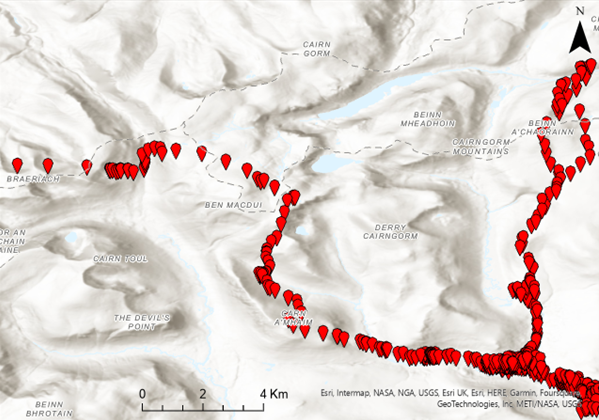Released wildcat travels to the National Trust for Scotland's Mar Lodge
A young wildcat that has spent the first year of its life in a captive environment is suddenly faced with the daunting prospect of freedom. With the opening of a door, everything changes: the wildcat can go anywhere it likes and do anything it wants. What does it do?
This question has occupied my every waking moment since we began planning for wildcat releases at the beginning of the Saving Wildcats partnership project in 2020. We have tried to predict, using all the available scientific evidence from Scotland and across the European range, where the wildcats will go, their preferred habitat, what they will eat, where they might meet domestic cats and even where and when they might get runover, so that we can mitigate the threats they will face and give them the best possible chance of survival.
A key aspect to the success of any species restoration project is the ‘site fidelity’ of the released animals, i.e., that they remain within the planned area to establish a population. Although limited, evidence from other species translocations (the movement of a species for conservation purposes) has suggested some potential methods of maximising site fidelity. These include soft-release, which involves temporary confinement of the animal in the release site to allow acclimatisation, and supplementary feeding, providing food and water after release. These strategies were both utilised by Saving Wildcats during the first releases this summer. The choice of release site is also key, in terms of the amount of suitable habitat and the presence of natural barriers that might slow or prevent movement in undesirable directions. But ultimately, the released animals are free to move wherever and however they like. By tracking them daily using GPS-radio collars, we are now able to look back on the months following the releases and start to answer some questions about their movement post-release.
At the time of writing, five months on from the first release, site fidelity has been relatively high. Although all the wildcats have dispersed away from the soft release pens, most (17 of 19) have remained within the Cairngorms Connect release site and some of the surrounding estates, moving an average of 6km away from their original release point. However, two of the 19 wildcats moved directly away from the release site, across a much further distance. This behaviour is known as ‘hyperdispersal’ in conservation translocations.
One of those two individuals was released in the south of Cairngorms Connect and quickly travelled north towards Cromdale. Sadly, she died of peritonitis in late September.
The second ‘hyperdisperser’ was a male wildcat, one of the last to be released in early September. Although we track the wildcats daily, we couldn’t find him in the days immediately after his release. The team were climbing every hill to search wide areas from high ground, but the wet and cloudy weather was hampering our efforts, and days and weeks went by with no trace. After two weeks of scouring maps and searching every inch of the release site, we were left with the remote but increasingly likely possibility that he might have gone over the Cairngorm plateau. Since he disappeared in the south of Cairngorms Connect, we suspected that he could be in one of the glens at the National Trust for Scotland's Mar Lodge, a whopping 29,000ha of varied habitats and Britain’s largest National Nature Reserve.
We got in touch with Shaila Rao at the Trust's Mar Lodge, and Mike Daniels, who works for the John Muir Trust but is based at Mar Lodge and has a history with Scotland’s wildcats, carrying out his PhD with wildcats in the 1990’s. Luckily for us, both Shaila and Mike have a lot of experience with wildcats, including radio-tracking, and were able to suggest some locations where he might be found.
Our team went over to Mar Lodge the next day and joined Mike in a long walk up a steep hill, to be rewarded (finally!) with the sweet sound of his ‘pings’ (the pinger of the radio tracker). They successfully downloaded two weeks’ worth of his GPS data, which we then uploaded as quickly possible to check that he was ok i.e., still moving (he was fine). The data was really incredible, revealing the fine details of his long-distance ‘stravaig’ during which he had scaled sheer cliffs, endured barren and windswept conditions, crossed several Munros, and covered a distance of over 30km in three days.
This bold wildcat visited several areas in Mar Lodge, usually following rivers, resting under the trees, and (presumably) hunting small mammals in the low ground. The Saving Wildcats team collect his data weekly with continued support from Shaila and Mike. Their assistance is incredibly helpful to the team because it takes a long time for us to get there from Strathspey and will be increasingly difficult once the winter weather takes hold.
We do not yet know what the future holds for this individual wildcat; he may remain at Mar Lodge in the longer term, or continue down the glen into Deeside, or he may even return to the release site. For now, we will continue to monitor him, with the help of Mar Lodge, and see where he chooses to go.
The National Trust for Scotland have supported Saving Wildcats since the project began and were one of the original funders of the partnership. We’re delighted that their commitment to ecological restoration at Mar Lodge has provided released wildcats with suitable habitat and that they continue to be involved in the conservation of wildcats in Scotland.


